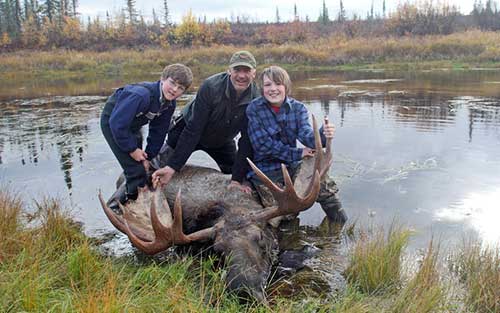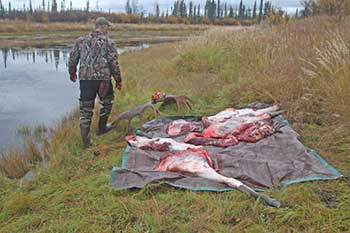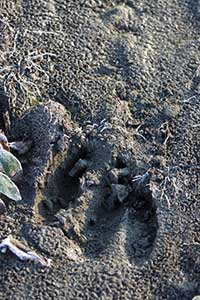Alaska Fish & Wildlife News
February 2014
Moose Luck: A Hunt in One
of the Planet’s Last, Best Wilderness Regions

Our hunt hadn’t yet started when, 30 miles up the Koyukuk River, the first moose appeared on a sandbar. Riverboat skipper Charlie Green snatched a rifle from behind his seat and shouted for his assistant to take the wheel. Then Charlie opened the cabin’s rain-splattered hatch and stepped onto the bow where the deck was cluttered with dry-bags, backpacks and gun cases. Charlie picked his way up front and sat down on a box, then motioned for his assistant to open the throttle. The outboard roared, closing in fast on the moose that now paused to stare at the boat.
We were within 200 yards when the bull turned and began walking away from the river toward a thicket of 12-foot-tall willows. Charlie waved at his assistant to cut the outboard, but by the time the boat glided to a stop on the beach, the moose had broken into a trot. Charlie stood, brought up his .300 H&H magnum and fired offhand. The 1,000-pound animal, carrying a rack that spread 56 inches, collapsed. Charlie’s perfect snapshot had caught it behind an ear.
The Koyukuk Basin
The Koyukuk River basin in September – moose hunting season – is a region of cool days and brittle-cold nights, the bottomlands a mosaic of oxbow sloughs, alder thickets, and sandbars from which mammoth bones sometimes protrude. All sounds here are measured against an ancient silence; most prominent by day are leaves rattling in the wind, the far-off trumpeting of migrating swans and, at the heart of everything, the electrical surge and murmur of rivers.
The country here is largely boreal, and on cool autumn days its spruce, birch and cottonwood forests meld with groundcovers of high-bush cranberry and wild rose to form vibrant compositions of red and gold. The river bottoms are bordered by willow thickets that run unbroken for miles providing choice browse for moose and even the occasional musk ox.
Geologically, the basin is a work in progress, constantly carved and sanded by the Koyukuk River whose origins reside in the surrounding Brooks Range and Nulato Hills. Alpine freshets formed by snowmelt and groundwater dash out of the high country and merge to form the powerful Koyukuk (locally pronounced Kie – ya – kuk), seasonally rich in salmon, whitefish, grayling and northern pike. Ultimately, the river joins the mile-wide Yukon where Galena, the region’s largest community, is located a short boat ride to the east.
Newcomers realize quickly that the basin is broad beyond imagination, and keenly remote. With no roads connecting the Koyukuk to an urbanized continent, most visitors arrive by commuter flight from Fairbanks to Galena. From here, the Yukon River and its countless regional tributaries serve as highways for travel by riverboat.
A Kateel River Draw Hunt
My friend Mark had drawn a sport-hunting permit for moose in the Kateel River country, which meant the bull spotted earlier far down the Koyukuk was not legal game for him. Charlie was able to take the moose because he had registered for a regional subsistence hunt. His only concession: One of the bull’s antler palms would need to be sawed in half and the top half surrendered to a state wildlife biologist stationed along the river at a hunter checkpoint. The rule discourages trophy hunters from taking moose under the guise of subsistence.
Charlie’s assistant, a slight, quiet young man named Dewey who peered with dark Native eyes through thick-lensed, black plastic-framed glasses, had stayed at the moose kill 60 miles downstream. “He loves to hunt,” Charlie explained, adding that Dewey was particularly adept at traditional subsistence black bear hunting. Soft-spoken Dewey, we learned, was known for peeling off his shirt and, in the spirit of his spear-wielding Athabascan forbearers, fearlessly crawling into bear dens with a .357 revolver to harvest the dozing occupants point-blank.
By the time Charlie returned to the kill late that evening, his moose would be cleanly skinned, drawn, and quartered. Charlie and Dewey would spend the night in the boat cabin, which featured beds, catalytic heater, DVD player and food, before returning to Galena next morning with the meat.
A few hours after Charlie took his moose on the Koyukuk, we arrived at a sandbar a dozen miles up the Kateel River, a narrow tributary winding out of the Nulato Hills, where Mark, his two young boys and I planned to disembark. We’d hired Charlie, a Galena resident and hunt transporter, to leave us a small riverboat and jet unit piloted upriver earlier and cached along with three drums of expensive rural gasoline.

The day was pretty much gone by the time Charlie, an Athabascan with a wry sense of humor, stepped into his boat proclaiming that Natives can see in the dark. “Guess we’ll find out,” he said. Then he laughed, fired up his outboard, and sped downriver into the dusk.
I listened as the outboard faded and soon found myself immersed in a profound silence. It occurred to me, as the stillness settled in, that we’d entered an older, more primitive universe. Moose were now fair game and their hoof prints, mixed with the tracks of grizzly and wolf, marked the sands all around.
As we hauled our gear up from the river, a cloud burst overhead, cooling our necks and dampening the mood. We pitched a tarp against the rain and Mark wondered aloud if maybe Charlie had spent all our moose luck downriver. Of course, he knew better. A big country surrounded us, and sign around camp suggested plenty of game. With the subarctic night falling hard and wet, all we needed was a good night’s sleep.
Wolves and Moose Calls
The next morning, like all to follow, broke to the music of wolves. The singing began about 30 minutes before first light with a baritone howl that floated across the river, rich and smooth as 25-year-old scotch. It was answered by a chorus of tenors a mile or so away, their voices uneven and charged with a youthful joy reminiscent of the way my own children, when they were little, once clamored as I walked in the door from a day at work.
I stepped from the tent, listening to the wolves, and saw several willow grouse buzzing overhead. Back and forth across the river they sailed, silhouetted by dawn’s first pink-and-orange traces, their plump bodies propelled by stubby, quivering wings. Leaving nighttime roosts for secret thickets and berry patches, they brought to mind safari accounts of sand grouse and francolin, game birds of East Africa, winging to waterholes at first light.
The morning was captivating, enhanced as it was by wolf song and the tangy berry smells of fall. At the same time, I felt a sense of mission. We had come, after all, to hunt moose. And until fresh meat hung in camp, we could not truly relax.
Following Charlie’s advice we spent that first day in the boat running upriver, watching for a moose to step out and be seen. Hoof prints marked all the sandbars and occasionally we would stop to follow a trail or investigate a promising slough. Several times Mark tried calling moose, grunting through a fiberglass horn and thrashing the willows in fruitless efforts to imitate a rutting bull. Once, drawn to a cut-bank pocked by fresh moose tracks, we’d left the boat to find where a bull had scraped the bark from some saplings while rubbing the velvet from its antlers.
We hunted all day, traveling upriver 20 miles or so, the channel narrowing as the hills grew higher and closed in around us. Our spirits probably matched the weather late that afternoon when, in a misting rain, we turned around. Fortunately, a pile of dry wood gathered that morning and protected beneath a tarp promised a fire later that evening, and a chance to consider our options over a shot of sweet Canadian whiskey.
Moose and Widgeon
Wolves howled again the next morning, but this time beneath a welcome dome of stars. The skies had cleared. Mark and his boys roared off in the boat shortly after daybreak and for a while I sat in camp, listening to autumn leaves clattering lightly to the ground. I’d stayed behind to hunt birds, explore the country and to be, for one day, completely alone. Now sunlight blazed through the trees on the river’s far side. I lingered over a cup of hot cocoa until the frosts vanished and the brush dried before stepping off our sandbar and into the endless forest.
Sometimes in life you simply get lucky. Like the time a guy I knew entered a convenience store for a soda pop and walked out with a pull-tab ticket worth $12,000. There had been no plan, no grand design on his part; he’d simply blundered into a small fortune – enough to pay off debts, maybe turn his life around. It was that kind of dumb luck that changed the course of our hunt.

I had stumbled upon a moose trail bordering an oxbow slough when a grouse flushed from the brush to my right. I swung my .20 gauge, fired a load of No. 5 steel intended for ducks through the first barrel, then the second – and missed both times. Amplified by the great silence around me, the shots seemed particularly loud. I wondered if shooting at grouse might spook moose out of the country. Then came sudden crashing from the trees nearby. The sound resembled someone beating tree trunks with a baseball bat or, I realized, like a bull challenging my gunshot by thrashing its antlers.
I continued along the trail and within a few steps glanced up to see a moose running ahead. Cow. I reckoned it was her boyfriend I’d heard rapping his antlers nearby. Other bulls seeking the cow’s company would likely be in the area, too.
Moments later I rounded a bend in the slough and kicked up a flock of widgeon. My shotgun was up in an instant and I dropped a bird with the first shot. The gunshot’s echoes had hardly stopped when crashing resumed in the trees. That moose had a chip on its shoulder; it was, I realized, mistaking my shooting for a head-banging rival bull.
Mark and his boys returned in the boat just before dark. They had traveled up another river south of camp and had found good country, but no moose. Nick, the youngest boy, turned 11 that day and had shot his first spruce grouse. In fact, Mark and the boys had found many grouse and Nick and his 12-year-old brother Curtis had each taken several.
Evening shadows crept over us and the sky grew inky as I shared the story of my day. I pointed toward the slough and told Mark of the bull that had responded to my gunshots. By the time we went to bed, a plan for the next morning had been made.
Success
A few stars still twinkled over the Nulatos when Mark stole out of camp for the oxbow slough. As the sky brightened to gunmetal gray, he quietly navigated a strip of forest separating the slough from the river. The slough that morning reflected the sky and at the water’s edge Mark found the moose trail cut deep and wide, cattle-style, among the sedges.
Not far from the spot where my willow grouse had flushed, Mark paused and looked down the channel. Mist rose over the water, the scene perfectly still. He picked up a stick and whacked it against a tree once, twice, three times. Nothing. No sound. No motion.
Minutes passed. Then, across the slough, something moved. Mark lifted his rifle, peered through his scope, and could hardly believe his eyes.
In camp, the boys were in the tent sleeping and I was outside kicking at the fire pit ashes when the rifle shot echoed over the river.
“What was that?” one of the boys called out, startled. I smiled. Get dressed, I answered. We had meat to pack.
Breaking Camp
Two days later, we broke camp in a snowstorm. The boat rode low, heavy with gear and meat; the river roiled black against snow-whitened banks. Flakes whirled, splattering against our faces like cold, wet kisses and leaving us damp and shivering. Mark bundled Nick in a sleeping bag as we motored slowly downriver. Then, moments later, Curtis pointed and shouted.
There on the bank, regal as a stag, stood a grand bull moose. “Sixty-inches,” I whispered to Mark.
Slowly, the bull, and a cow standing with it, turned and walked into the willows. As we watched them go it occurred to me that the best things in life change little with time. Years pass, the world grows older, but the willows, moose and seasons – the things hunters know best and truly love – remain.
We looked ahead through the falling snow toward our planned rendezvous with Charlie on the Koyukuk. He would smile when he saw the boat heaped high with moose, and compliment us: “Damn,” he would say, admiring the unsoiled hams and ribs, “you guys take good care of your meat.” We would load everything onto Charlie’s boat. Then he would fire up his outboard one last time and, in a heartbeat, we would vanish into the blizzard.
Ken Marsh is a longtime Alaska hunter, writer and information officer with the Alaska Department of Fish and Game in Anchorage.
Subscribe to be notified about new issues
Receive a monthly notice about new issues and articles.
